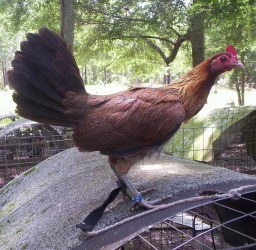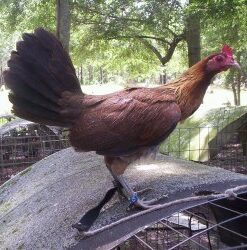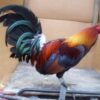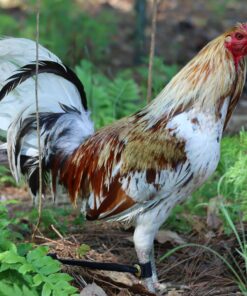Blueface Hatch Game Fowl
$350.00 – $1,250.00
Appearance: Regular
Agility: 5/10
Type: Offensive Game Fowl
Records: Crosses to Produce Perfect Fierce Blueface Hatch Chicks.
Blueface Hatch Game Fowl
Blueface Hatch Game Fowl is always bred and conditioned for increased stamina and strength to produce chickens that are either cocks or hens called game fowls. These hens are not bred to fight when matured, but they are bred, fed, and groomed with protein, and calcium-rich food to enable them to produce chicks that are highly resistant to flues and other fowl illnesses. Also producing resistant and long-lasting generational fighting stamina Blueface Hatch Game Fowl.
Cockfighting is a blood sport due in some part to the physical trauma the cocks inflict on each other. This is sometimes increased by attaching metal spurs to the cocks’ natural spurs. While not all fights are to the death, the cocks may endure significant physical trauma. In some areas around the world, cockfighting is still practiced as a mainstream event. In some countries, it is regulated by law, or forbidden outright.
About Cockpit
A cockfight is a blood sport, held in a ring called a cockpit. The history of raising fowl for fighting goes back 6,000 years. The first documented use of the word gamecock, denoting use of the cock as to a “game”, a sport, pastime, or entertainment.
The combatants, referred to as gamecocks (not to be confused with game birds), are specially bred and conditioned for increased stamina and strength. Male and female chickens of such a breed are referred to as game fowl. Cocks possess congenital aggression toward all males of the same species. Wagers are often made on the outcome of the match.
Two owners place their gamecock in the cockpit. Blueface Hatch Game Fowl fights until ultimately one of them dies or is critically injured. Historically, this was in a cockpit, which is a term used to mean a place of entertainment or frenzied activity.
Blueface Hatch Game Fowl: A Legacy of Strength and Speed
The Blueface Hatch is one of the most iconic bloodlines in the world of American game fowl. Known for its speed, cutting ability, and gameness, the Blueface Hatch has earned a solid reputation among breeders, trainers, and enthusiasts for decades. This bloodline has not only stood the test of time but also continues to be a favorite in breeding programs due to its performance and striking appearance.
Origins and History
The Blueface Hatch line traces its roots back to the Hatch family of gamefowl, which itself was developed by Sanford Hatch in the early 1900s. Sanford Hatch blended several proven bloodlines — including the Kearney Whitehackle, Herman Duryea’s fowl, and others — to create a line known for power, aggression, and gameness.
The Blueface variation emerged when Ruben “Shorty” Bullock introduced a blue-faced (slate-legged) infusion into the Hatch bloodline. This blue-legged trait, coupled with razor-sharp cutting ability and unmatched tenacity, gave rise to what is now known as the Blueface Hatch.
Physical Characteristics
The Blueface Hatch is easily recognizable by a few standout features:
-
Leg Color: Slate-blue or greenish legs (hence the name “Blueface”)
-
Feathering: Typically comes in green-legged red, yellow-legged red, or light red plumage
-
Build: Medium station, muscular build, broad shoulders, and strong legs
-
Eyes: Often pearl or white, giving them an intense, alert expression
This combination of physical traits contributes to their agility and striking presence in the ring.
Temperament and Performance
Blueface Hatch gamefowl are renowned for:
-
Speed: One of the fastest striking bloodlines in the gamefowl world
-
Smartness: Known for being highly intelligent, with excellent timing and movement
-
Cutting Ability: Exceptional cutting power, often finishing quickly
-
Gameness: True to their Hatch lineage, they exhibit strong endurance and fighting spirit
While their speed and cutting ability often give them an edge, what sets them apart is their ability to think and adapt during a contest — a trait highly prized among gamefowl breeders.
Breeding and Crosses
The Blueface Hatch is often used in crossbreeding programs to improve speed and cut in other bloodlines. Some popular crosses include:
-
Blueface x Sweater: For added power and aggression
-
Blueface x Roundhead: For balance and improved intelligence
-
Blueface x Kelso: For durability and cutting finesse
These crosses are often aimed at combining the best traits — gameness, intelligence, and speed — into a single fighting fowl.
| Select Fowl | Pairs, Pullets, Stags, Trio |
|---|---|
| Gender | Female, Male |
Be the first to review “Blueface Hatch Game Fowl” Cancel reply
Related products
GAME FOWLS FOR SALE
Fighting Roosters
GAME FOWLS FOR SALE
GAME FOWLS FOR SALE
Fighting Roosters
GAME FOWLS FOR SALE
GAME FOWLS FOR SALE
GAME FOWLS FOR SALE
















Reviews
There are no reviews yet.